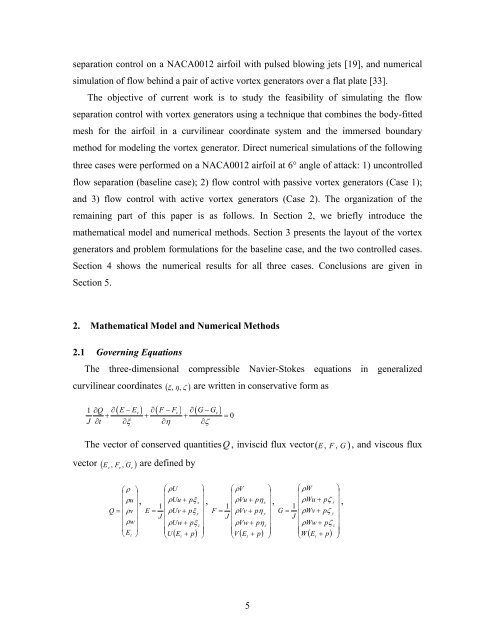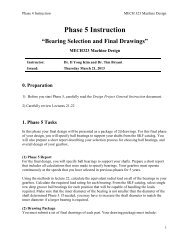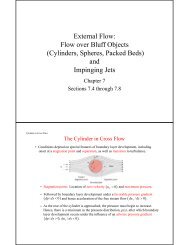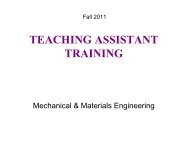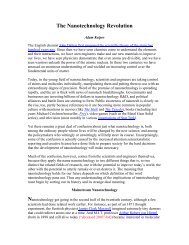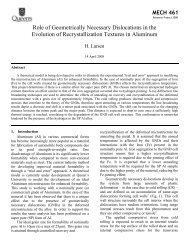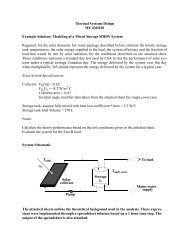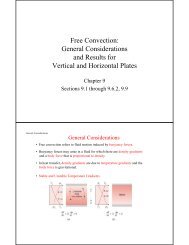Numerical Study of Passive and Active Flow Separation Control ...
Numerical Study of Passive and Active Flow Separation Control ...
Numerical Study of Passive and Active Flow Separation Control ...
Create successful ePaper yourself
Turn your PDF publications into a flip-book with our unique Google optimized e-Paper software.
separation control on a NACA0012 airfoil with pulsed blowing jets [19], <strong>and</strong> numerical<br />
simulation <strong>of</strong> flow behind a pair <strong>of</strong> active vortex generators over a flat plate [33].<br />
The objective <strong>of</strong> current work is to study the feasibility <strong>of</strong> simulating the flow<br />
separation control with vortex generators using a technique that combines the body-fitted<br />
mesh for the airfoil in a curvilinear coordinate system <strong>and</strong> the immersed boundary<br />
method for modeling the vortex generator. Direct numerical simulations <strong>of</strong> the following<br />
three cases were performed on a NACA0012 airfoil at 6° angle <strong>of</strong> attack: 1) uncontrolled<br />
flow separation (baseline case); 2) flow control with passive vortex generators (Case 1);<br />
<strong>and</strong> 3) flow control with active vortex generators (Case 2). The organization <strong>of</strong> the<br />
remaining part <strong>of</strong> this paper is as follows. In Section 2, we briefly introduce the<br />
mathematical model <strong>and</strong> numerical methods. Section 3 presents the layout <strong>of</strong> the vortex<br />
generators <strong>and</strong> problem formulations for the baseline case, <strong>and</strong> the two controlled cases.<br />
Section 4 shows the numerical results for all three cases. Conclusions are given in<br />
Section 5.<br />
2. Mathematical Model <strong>and</strong> <strong>Numerical</strong> Methods<br />
2.1 Governing Equations<br />
The three-dimensional compressible Navier-Stokes equations in generalized<br />
curvilinear coordinates ( ξ , η,<br />
ζ ) are written in conservative form as<br />
( E E ) ( F F ) ( G G )<br />
1 ∂ Q ∂ − v ∂ − v ∂ − v<br />
+ + + = 0<br />
J ∂t ∂ξ ∂η ∂ζ<br />
The vector <strong>of</strong> conserved quantitiesQ , inviscid flux vector ( E , F , G ) , <strong>and</strong> viscous flux<br />
vector ( E , F , G ) are defined by<br />
v<br />
v<br />
v<br />
⎛ ρ ⎞<br />
⎜ ⎟<br />
⎜ ρu<br />
⎟<br />
Q = ⎜ ρv<br />
⎟<br />
⎜ ⎟<br />
⎜ ρw⎟<br />
⎜ ⎟<br />
⎝ Et<br />
⎠<br />
,<br />
( ) ⎟⎟⎟⎟⎟⎟⎟<br />
⎛ ρU<br />
⎞<br />
⎜<br />
⎜ ρUu<br />
+ pξ<br />
x<br />
1 ⎜<br />
E =<br />
⎜<br />
ρUv<br />
+ pξ<br />
y<br />
J<br />
⎜ ρUw<br />
+ pξ<br />
z<br />
⎜<br />
⎝U<br />
Et<br />
+ p ⎠<br />
,<br />
( ) ⎟⎟⎟⎟⎟⎟⎟<br />
⎛ ρV<br />
⎞<br />
⎜<br />
⎜ ρVu<br />
+ pη<br />
x<br />
1 ⎜<br />
F =<br />
⎜<br />
ρVv<br />
+ pη<br />
y<br />
J<br />
⎜ ρVw<br />
+ pη<br />
z<br />
⎜<br />
⎝V<br />
Et<br />
+ p ⎠<br />
5<br />
,<br />
( ) ⎟⎟⎟⎟⎟⎟⎟<br />
⎛ ρW<br />
⎞<br />
⎜<br />
⎜ ρWu<br />
+ pζ<br />
x<br />
1 ⎜<br />
G =<br />
⎜<br />
ρWv<br />
+ pζ<br />
y<br />
J<br />
⎜ ρWw<br />
+ pζ<br />
z<br />
⎜<br />
⎝W<br />
Et<br />
+ p ⎠<br />
,


